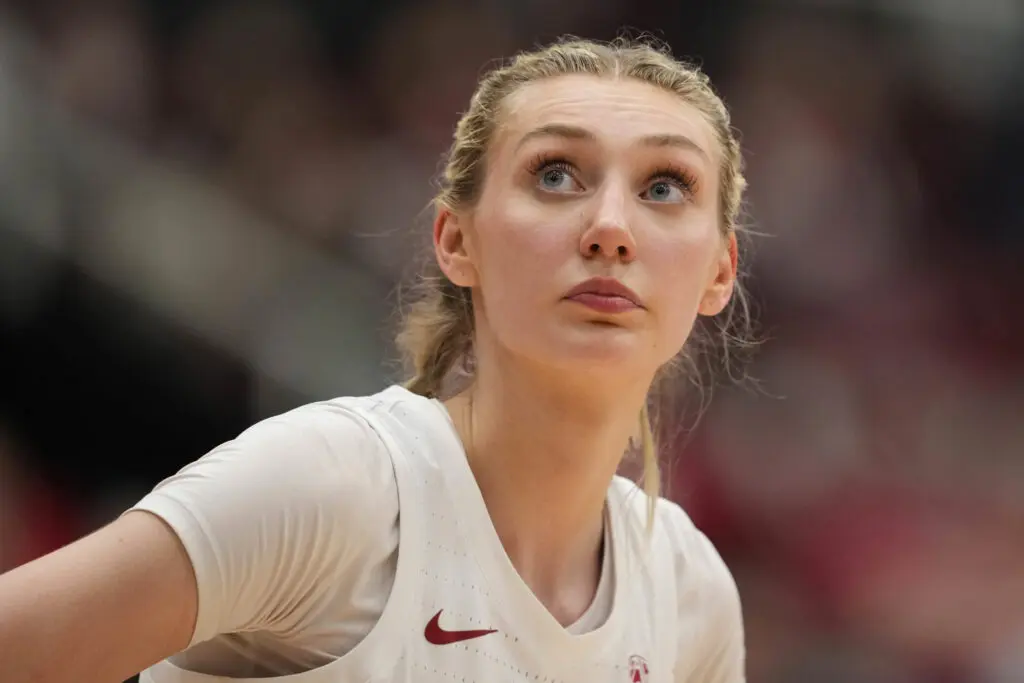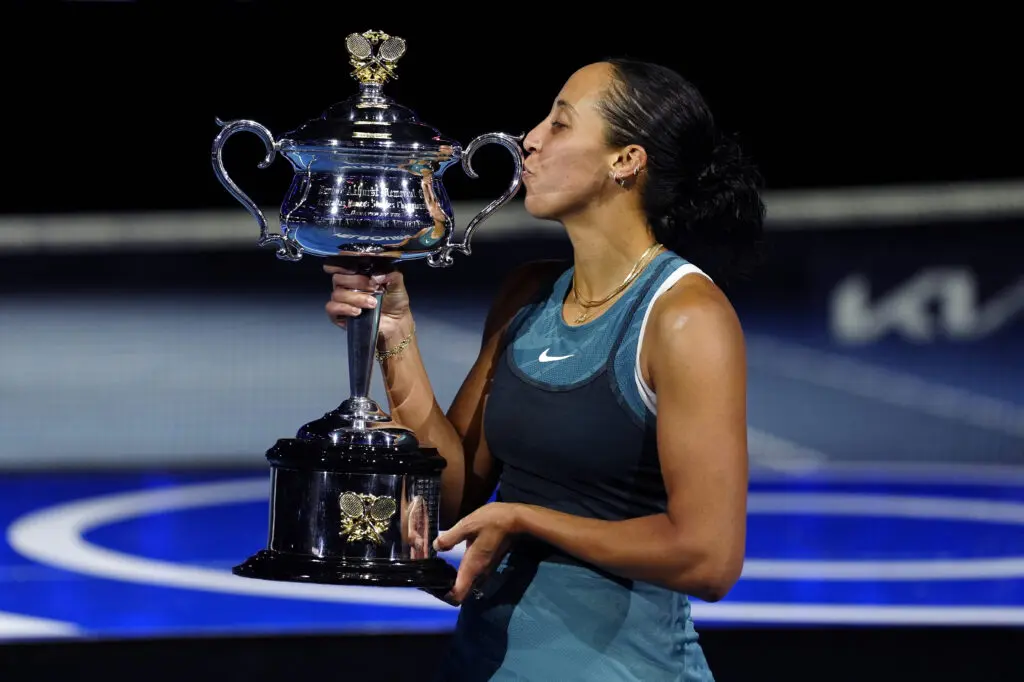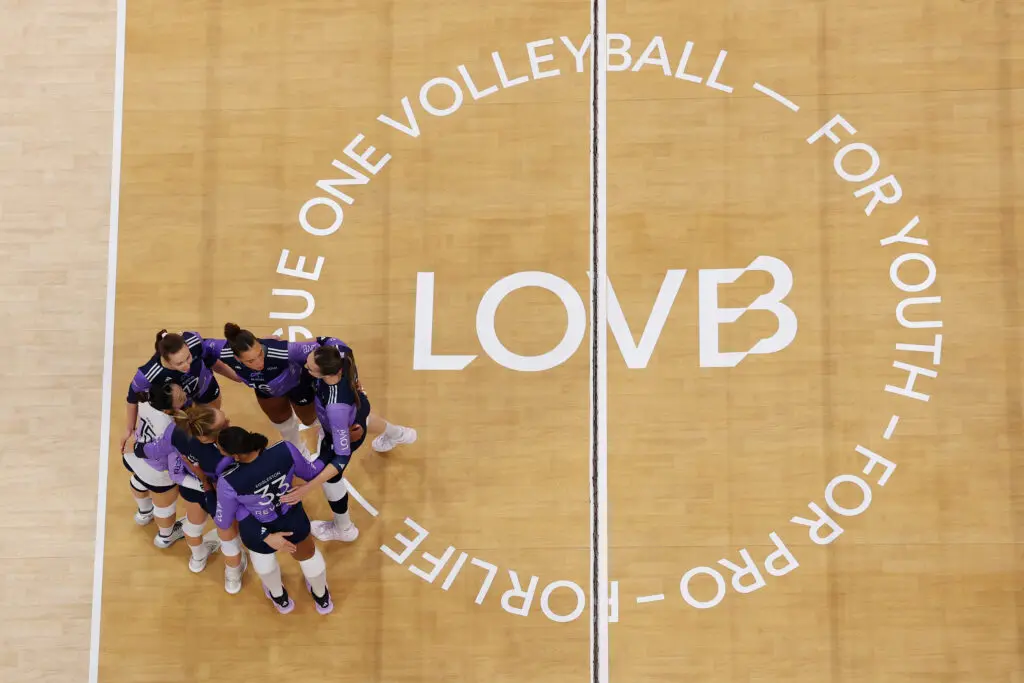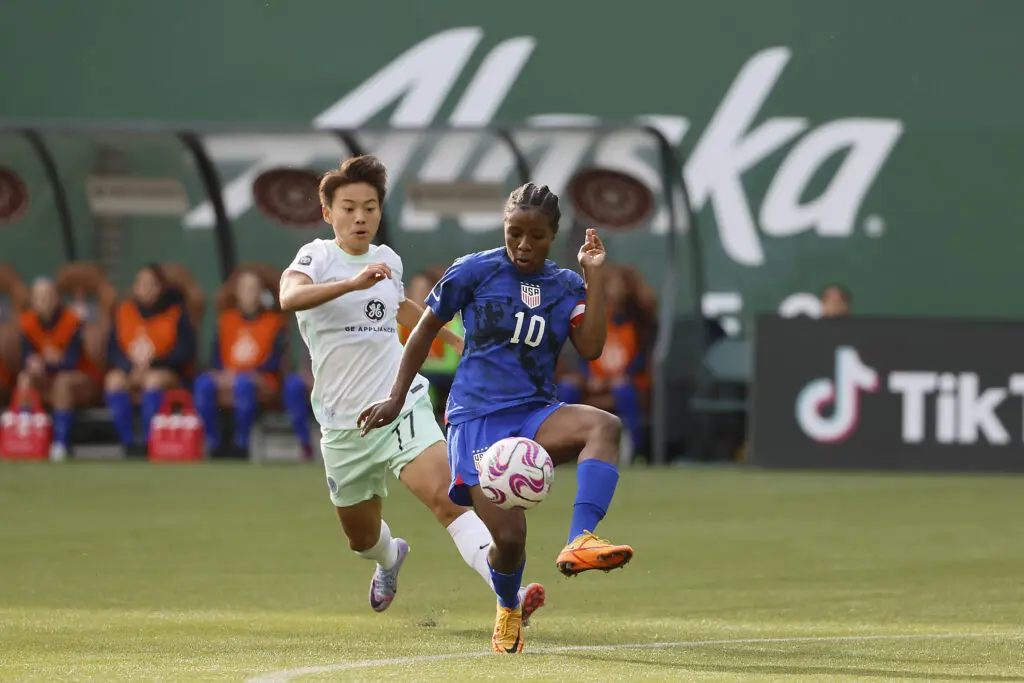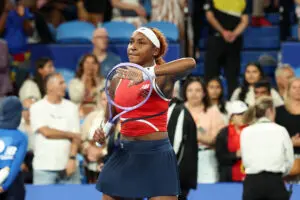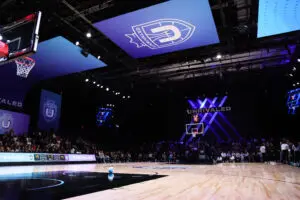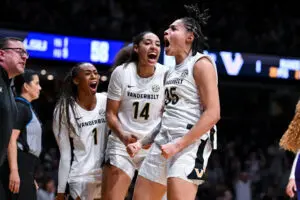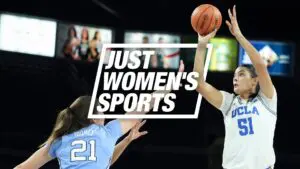Cameron Brink has a note taped to the inside of her locker. It’s there so she can see it every day — before every practice, after every game. Even if she opens her locker because she forgot something, it’s there, reminding her.
It’s from a former Stanford staff member, Jaylyn Savage. When she left to take another job, she wrote Brink the note.
Composed with thick black ink on white paper, it starts with a greeting. Then comes the part that has stuck with Brink since she first read it.
“It’s so refreshing to see someone as talented as you still be a kid at heart. Never lose that quality. So many athletes of your caliber don’t have that.”
She’s trying not to.
As a basketball player, Brink is thriving. She’s averaging a near double-double with 14.4 points and 9.6 rebounds per game for No. 6 Stanford, and she’s second in the country with 3.6 blocks per contest. Brink was on the cover of SLAM and is a Wooden Award candidate. She’s even tempered the foul problem that plagued her first two seasons. And on Jan. 29, she pulled off a rare feat, recording a triple-double with 10 blocks.
On the court, she’s the best she’s ever been.
Off the court, things aren’t as easy.
Sometimes, Brink lays in bed at the end of the day and thinks about how great everything should be.
“But I don’t feel OK,” she says. “And that’s scary.”
That’s why the note means so much to Brink. Because Savage saw through everything else. Savage saw her for her.
Beyond the intense player on the court. Beyond the pretty face partnering with companies on Instagram. Beyond the Stanford student. Beyond the mental health advocate.
Beyond her own negative thoughts.
Just Cameron.
So when days get heavy, when outside voices are talking too much, or when the chatter in her own head can’t be quieted, Brink can look at the note and know who she is.
***
Cameron Brink’s relationship with basketball started with resistance.
Her early memories were centered on things on the outskirts of the game itself. The outfits she wore, the music that played, the people she loved.
Cameron’s introduction to the sport came at Davidson. Her godbrother, Stephen Curry, was playing for the Wildcats, and the Brinks were in attendance. Cameron couldn’t tell you the score of that first game or how Curry played. But she can recall her excitement about the red-and-white cheerleader outfit she was wearing and the tall brown boots her mom paired with it. She remembers dancing in the crowd and the pure joy that came along with being allowed to wear a temporary tattoo on her face.
“I loved him and I loved the atmosphere. I loved putting on the outfit, but I was not good at paying attention,” she laughs. “It sounds terrible, but it all felt so normal to me. It was just what we did. I grew up around it.”
Basketball is written into the Brink family history.
Michelle Bain and Greg Brink attended Virginia Tech at the same time on basketball scholarships. Their practice facilities were connected by a common hallway, and every day the two passed each other with friendly greetings and flirty jokes. But Greg was shy and never made a move, so after a few years of their hallway meetings, Michelle knew it would fall to her to take their relationship out of the friend zone.
She invited Greg to a pick-up game, and the rest is history.
Their relationship — and eventual marriage — led to long careers at Nike as well as friendships with other athletes, including Dell and Sonya Curry.
By the time Cameron and her older brother Cy were born, the sport had been a catalyst for countless milestones in Michelle and Greg’s lives. Perhaps that’s why Cameron was so resistant to the sport at first. It was commonplace, and she had too much spirit to be the same.
“I always like to be contrarian,” she says.
In Cameron’s young mind, there were better things to do. She dreamt of being an artist, so she went to art camp. She was fascinated with space and spent time researching and learning about wormholes. She sat for hours discussing Pokémon with Cy — Blaziken and Charizard are still her favorites.
Michelle and Greg encouraged her to explore those interests. They didn’t force basketball on her. They knew better.
“If you’re the one pushing your kid into the sport, it’s not going to end well for anyone,” Michelle says with a laugh. “They have to want to do it.”
And even when Cameron finally gave basketball a chance, it wasn’t the love of the game that inspired her to keep going. That came later. Instead, it was her innate desire to win.
One summer the Brinks came back to the United States from Amsterdam, where Cameron lived from ages 8-11 thanks to her parents’ jobs with Nike. She had planned to spend her summer drawing and lounging by the pool. Instead, she went to basketball camp.
Cameron needed a way to expend some of her bubbling energy, so Michelle made her a deal. “If you try this camp for one day, we will take you whitewater rafting,” she told her daughter.
It was an intriguing proposition, so Cameron accepted. Besides, if she hated it, Michelle assured her that she wouldn’t have to go back.
She did hate it. Cameron came home with her hair plastered to her forehead, sweaty from the camp that took place mostly outside in humid North Carolina. Most of the other campers were boys who had years of experience, and compared to them, Cameron was terrible.
She hated that more than she hated the idea of playing basketball.
So, with the desire to win propelling her, Cameron went back. And before she knew it, the little contrarian was just like everyone else. She finally loved basketball.
***
Cameron Brink was desperate to be tall.
So desperate that the idea of being under 6-feet made her cry.
Michelle remembers taking Cameron to a pediatrician when they moved from Amsterdam to Oregon. During the check-up, a nurse took her height and weight and then plotted it on a graph to predict how tall 11-year-old Cameron would be as an adult.
The nurse looked at Cameron and informed her that she would grow to be 5-foot-11. Cameron whipped her head around to look at Michelle. Her blue eyes welled with tears and her lower lip protruded into a pout.
The nurse tried her best to reassure the young patient. “You have tall parents,” she said, “so you’ll probably be tall, too.”
But the nurse didn’t understand. Michelle was 6-3, Greg was 6-7, and Cy was already rocketing up in height — he eventually grew to be 6-9. Five-foot-11 was not tall.
“No,” Cameron said. “I want to be taller than my mom!”
Just a few years after that appointment, she was. But by then she was in high school, and suddenly, being tall wasn’t as much fun.
Cameron also played volleyball, and during her freshman season the team had a dress code for game days: no pants; skirts or dresses only. As a kid, Cameron loved dressing up, but as she grew up and into sports, Cameron felt out of place in a dress. Now, she was being pushed out of her comfort zone.
Michelle remembers her daughter in turmoil trying to find something to wear. Skirts were too short on her tall frame. She didn’t have the right shoes. It wasn’t her clothes that were the problem, it was her body. The height Cameron once coveted was suddenly undesirable, and her frame was no longer slender, it was too skinny. At least, that’s what she was hearing.
“She suffered a fair amount of body-shaming, even from her teammates,” Michelle says. “And it made her very self-conscious.”
As she progressed through high school, things got worse. Cameron was thriving on the basketball court, leading Southridge High School to two state titles, but she was miserable.
“We noticed the joy of the game being sucked away,” Michelle says. “And if you can’t have fun playing in high school, then when can you?”
Cameron doesn’t say much about those days at Southridge.
It feels so long ago now, but at the time, what she calls “high school drama” consumed her. After three years there, Cameron realized it wasn’t a healthy atmosphere. So, with one year remaining, she transferred to Mountainside, a school that had just opened in 2017.
“I wouldn’t even say I was being bullied,” Cameron says. “Because bullying gives them too much power. They weren’t bullies. And I just decided to remove myself. I knew I deserved better, so I left. And I’m happy I did.”
It was the right decision, but at the time, Cameron agonized over it. And when she officially filed her transfer paperwork, things got worse before they got better.
“I was distraught,” she says. “Because kids can be so mean, and so hateful.”
Former classmates egged and toilet-papered her house so many times that the Brinks had to get a security system. They could have pressed charges, but they didn’t bother. Instead, she emerged from the experience with a new mindset.
“Stop questioning yourself. Be authentically you,” she says. “Don’t change for others, and don’t give others the power to make you feel small.”
Now, she embraces all six feet and four inches of herself.
Being tall, she says, is one of her favorite things. The fears she had about wearing skirts and dresses during her freshman year are gone, too. She channels little Cam in her Davidson cheerleader outfit and wears what she wants, when she wants.
Her signature game-day hairstyle — two long, blonde braids — is just one piece of the puzzle. Now, Cameron loves how she looks in her uniform, in a chic makeup look, in a dress, and even in a bikini. Her Instagram account showcases all of those looks in a perfectly curated grid of pictures.
At first, Michelle was worried about the swimsuit photos.
“I was like, ‘Cameron, are you sure that’s what you want to put out there?’ But then I thought about it, and we talked about what an empowering statement it is for her,” Michelle says. “So I’ve learned to love it, because she’s confident and comfortable in her own skin. It’s a positive outcome for everything she suffered in high school.”
***
Cameron Brink can be as good as she wants to be.
That’s what Curtis Borchardt remembers thinking when he met her at 14 years old. He and his wife Susan King Borchardt, both former Stanford basketball players, train professional athletes such as Breanna Stewart, Sue Bird and Kelsey Plum. Never teenagers.
But they both felt a pull to Cameron.
The Borchardts had just moved to Oregon and ended up five minutes away from the Brinks. Cameron was fresh off a Stanford basketball camp, and staff members knew Susan could help the teen, already 6-4 and all limbs. While Susan and Cameron worked on strengthening her body, Curtis became her post coach.
Susan can still remember the first conversation she had with Cameron.
Despite her height, Cameron managed to make herself small sitting at the table with her mom. She kept her head down and didn’t make eye contact with Susan. With every question, Cameron glanced up at Michelle, who had to do all the talking.
“To see this beautiful, confident woman now, so much growth has happened,” Susan says.
“She’s like this unicorn athlete who is so graceful and in control of her body, but when we first started, I’d be like, ‘OK Cam, let’s try a reverse lunge,’ and she legit fell on her ass.”
But even then, when Cameron was quiet and a bit awkward on her feet, Susan could sense an innate passion.
It’s easy to see now when the junior blocks shots and lets out screams of celebration. Or when she runs to hug a teammate after a big play. Susan watched firsthand as Cameron took that flickering spirit and set it completely ablaze.
“She’s got some fire to her in a way that not a lot of people do,” Susan says. “I love that you can see that when you watch her play now.”
When Curtis met Cameron, he felt a kinship to her. At 7-feet tall, Curtis also had all the physical gifts necessary to excel, but he didn’t get specialized post coaching until college. In Cameron, he saw himself, and he wanted to help her.
After their first session, Curtis sent a text to Cameron’s mom: “The sky’s the limit.”
She picked up on things quickly and had an attention to detail that surprised him. But more than anything, he loved how fearless she was.
Off the court, Cameron couldn’t look Susan in the eye. On it, she wasn’t afraid of anything. Including Curtis.
“She was going against a 7-foot, 245-pound man, and I was guarding her with some physicality,” he says. “She never backed away from that.”
After watching Cameron grow up on and off the court, the Borchardts think of her like their fifth child.
Every time she’s home, Cameron makes sure to spend time with her second family, and when she’s back at school, the Borchardt kids love watching her play on TV.
“We may have played there, but I think Cameron made Stanford cool in their eyes,” Curtis says with a laugh.
Curtis and Susan can’t take credit for Cameron’s decision to play for the Cardinal, either. That was all thanks to her older brother.
Cameron says most people think of her as a jock and don’t know how much she loves to learn. She credits Cy for instilling that quality in her. Cy was the kind of kid that read atlases for fun and memorized facts about the Egyptian pyramids. His photographic memory earned him the nickname “Google.”
For Cameron, her older brother made it cool to be smart. He also inspired her to reach for more academically.
“He has really helped me appreciate a love of learning,” Cameron says. “He really motivated me to get into Stanford.”
And once the school was on her radar, Cameron had no interest in going anywhere else. It was the first school to offer her a scholarship, though the Brinks didn’t realize it at the time.
Cameron attended a camp in eighth grade, and afterward, former associate head coach Amy Tucker approached her parents and told them, “We’d love for her to come here.”
The meaning got lost in translation. Tucker meant on a basketball scholarship, but the Brinks assumed she was encouraging Cameron to come back to camp the next year. It wasn’t until other offers started flooding in that they realized what Tucker had meant.
That camp opened their eyes to just how good Cameron was and could be. As former college basketball players themselves, her parents knew she had potential, but it was easier to see the things she needed to work on.
“I don’t think we dared dream that she was going to be as good as she turned out to be,” Greg says. “So it actually took other people telling us.”
Michelle and Greg knew Cameron had her heart set on Stanford, but they wanted her to keep her options open. She went on unofficial visits to UConn and South Carolina, and Nebraska wanted her to play volleyball and basketball. All great options, just not for Cameron.
“We tried to open her mind to other schools, but she wasn’t having it,” Michelle says.
At Stanford, the Brinks have watched their daughter blossom. She loves going back to Oregon when she gets the chance to play foosball with her brother and eat chocolate waffles with her family. But Stanford is just as much home to her as Oregon is.
She’s forged friendships that make her high school tribulations seem far away. Like with Brooke Demetre, a sophomore on the Cardinal basketball team. She’s the kind of friend who doesn’t mind styling Cameron’s hair into her signature braids before every game. Cameron knows she will eventually need to learn to braid her own hair, but she enjoys the pregame routine with Demetre, who Cameron always repays with a cup of coffee.
She has a special bond with coach Tara VanDerveer as well. She’s funny, Cameron says, and a straight-shooter. VanDerveer always tells it like it is, even when it’s hard to hear.
When Cameron first got on Stanford’s radar, VanDerveer was worried she might not be strong enough, tricked by her thin frame and narrow shoulders.
“Just wait,” Susan said. “Just wait.”
VanDerveer is glad she listened.
***
Cameron Brink doesn’t always know how to be happy.
When she was younger, she thought of herself as a worrier. But worries go away. This didn’t.
During her freshman year in college, COVID-19 hit, and the negativity consumed her. On the outside, Cameron was a phenom, helping Stanford to a national title, the program’s first since 1992. But on the inside, she felt isolated, confused, uneasy. It was then that her worries got a name: anxiety. And with the name came the guilt.
She had no reason to feel this way, she thought, and that made Cameron feel worse.
“I feel so guilty because I live this privileged life,” she says. “And I have so many blessings, so many people who love me, and I’m doing relatively well in basketball. So, why do I feel bad?”
Neither her looks, which were once a source of stress, nor her abilities on the basketball court are causes of anxiety for Cameron. It’s coming from some unknown place, one she has yet to discover.
“It’s just stuff that’s kind of out of my control,” she says. “Which kind of sends you into more of a spiral.”
It’s a never-ending cycle, and one she’s learning to live with.
“My therapist said that human suffering is pain and resistance, and resisting it makes it worse,” Cameron says. “So I think it’s just been accepting it, and that has made it so much better for me. I’m allowing myself to feel.”
Cameron approaches her therapy sessions like she approaches her classes at Stanford. She’s a sponge, ready to soak up as much knowledge as possible. But mental health doesn’t have a textbook. Cameron does her best to learn. And even though she doesn’t fully understand the anxiety that plagues her, there’s one thing about her mental health struggles she knows for sure: She has to talk about them.
That’s why she’s focused a lot of her NIL partnerships on mental health, like the one she has with Chegg, promoting self-care and mindfulness.
Cameron knows what it’s like to be surrounded by people and still feel alone. And if there is a way to lift that loneliness off the shoulders of someone else, she wants to do it.
“You’ll be in a room full of people you love so much, and you’ll be having these thoughts like, ‘Why can’t I just be present?’ And it’s this constant internal battle,” Cameron says. “That’s why I want to talk about it more, because it’s truly such a scary feeling.”
It would be a beautiful story if Cameron could say that she started therapy and the anxiety melted away. If her mental health struggles had been tied up with a bow and cast aside.
Instead, despite all the work she does everyday, things have gotten worse. And she has no idea why.
“I feel like I’m beating myself up because I feel like everything should be fine,” she says. “I go to therapy twice a week to try to figure it out, but it opens up more wounds, and speaking about it makes it more real sometimes. But it’s helping. Therapy helps.”
There’s beauty in that, too. The realness of it all. And as therapy helps Cameron, she’s able to help others.
Recently, Cameron held a basketball camp for young girls. One day during lunch, the campers were treated to pizza and a Q&A session with the Stanford star. Nothing was off limits. One by one, the girls raised their hands. They asked. Cameron answered. Basketball barely came up.
“They asked me so many insightful questions,” she says. “It was nice to have an honest conversation with them. I told them there are a lot of days that are really hard. But it was really cool to connect with these girls on a deeper level.”
That moment, shared over pizza with girls that want to be just like her, is one that Cameron comes back to often. She feels its impact in her daily life. And she’s not the only one feeling the positive effects.
“She’s going to impact more lives that she’s even aware of,” Curtis says.
***
Cameron Brink is a study in contrast.
She’s like a coin with infinite sides. The more you flip it, the more you learn.
The Cameron you see on the court is just one side. A fierce competitor who, as her mom says, will step on your neck if you get in her way.
A 6-4 shot-blocking machine with long, blonde braids, icy-blue eyes and a sugar-cube smile.
She’s also that little girl in a Davidson cheerleading uniform.
She’s tall. She’s strong. She’s brave. She’s beautiful.
She’s Cy’s sister, Michelle and Greg’s daughter. Steph’s godsister. Brooke’s coffee-drinking and hair-braiding buddy.
She has a wonderful, privileged life. And she has anxiety. Both of those things can exist at once.
And though many of her traits seem to be at odds with each other, they combine to make Cameron Brink perfectly herself.
That’s something she never wants to lose.
Eden Laase is a Staff Writer at Just Women’s Sports. Follow her on Twitter @eden_laase.
